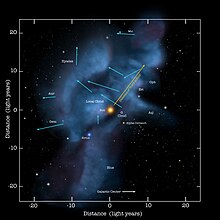Local Interstellar Cloud
| Interstellar cloud | |
|---|---|
| low density warm hydrogen | |

Diagram of the local clouds of matter that the Solar System is moving through, with arrows indicating cloud motion.
|
|
| Observation data | |
| Distance | 0 ly (0 pc) |
| Physical characteristics | |
| Dimensions | 30 ly (9.2 pc) |
| Designations | Local Cloud, LIC |
The Local Interstellar Cloud (LIC), also known as the Local Fluff, is the interstellar cloud roughly 30 light-years (9.2 pc) across through which the Solar System is currently moving. It is currently unknown if the Sun is embedded in the Local Interstellar Cloud, or in the region where the Local Interstellar Cloud is interacting with the neighboring G-Cloud.
The Solar System is located within a structure called the Local Bubble, a low-density region of the galactic interstellar medium. Within this region is the Local Interstellar Cloud, a region of slightly higher hydrogen density. The Sun is near the edge of the Local Interstellar Cloud. It is thought to have entered the region at some point between 44,000 and 150,000 years ago and is expected to remain within it for another 10,000 to 20,000 years.
The cloud has a temperature of about 7,000 K (6,730 °C; 12,140 °F), about the same temperature as the surface of the Sun. However, its specific heat capacity is very low because it is not very dense, with 0.3 atoms per cubic centimetre (4.9/cu in). This is less dense than the average for the interstellar medium in the Milky Way (0.5/cm3 or 8.2/cu in), though six times denser than the gas in the hot, low-density Local Bubble (0.05/cm3 or 0.82/cu in) which surrounds the local cloud. In comparison, Earth's atmosphere at the edge of space has around 1.2×1013 molecules per cubic centimeter, dropping to around 50 million (5.0×107) at 450 km (280 mi).
The cloud is flowing outwards from the Scorpius–Centaurus Association, a stellar association that is a star-forming region.
In 2009, Voyager 2 data suggested that the magnetic strength of the local interstellar medium was much stronger than expected (370 to 550 picoteslas (pT), against previous estimates of 180 to 250 pT). The fact that the Local Interstellar Cloud is strongly magnetized could explain its continued existence despite the pressures exerted upon it by the winds that blew out the Local Bubble.
...
Wikipedia
